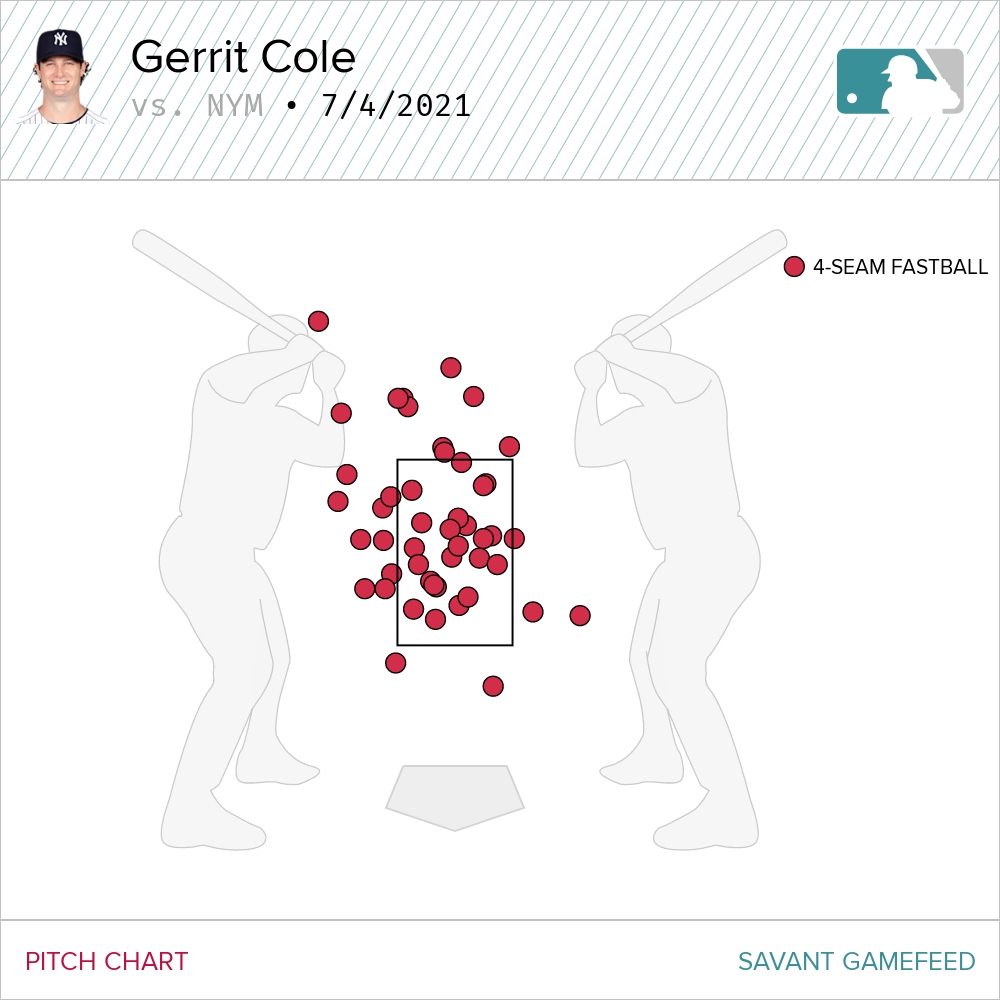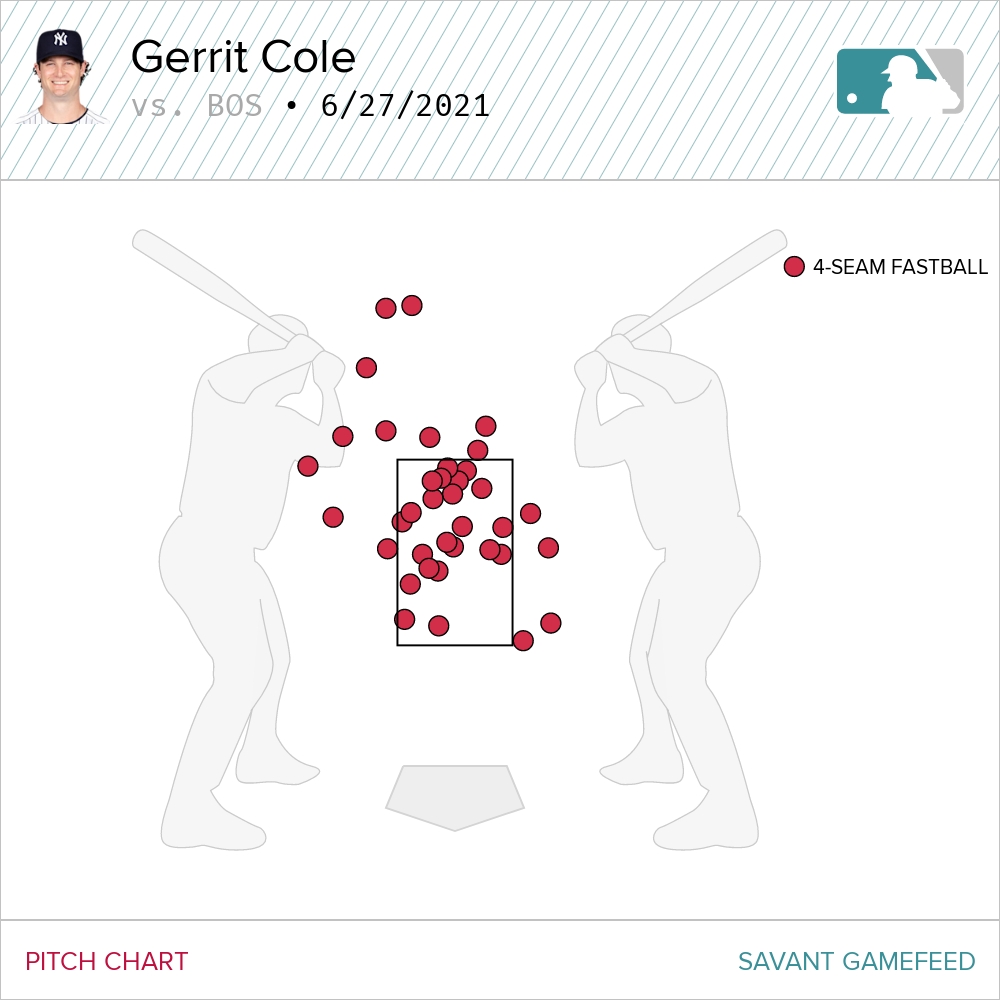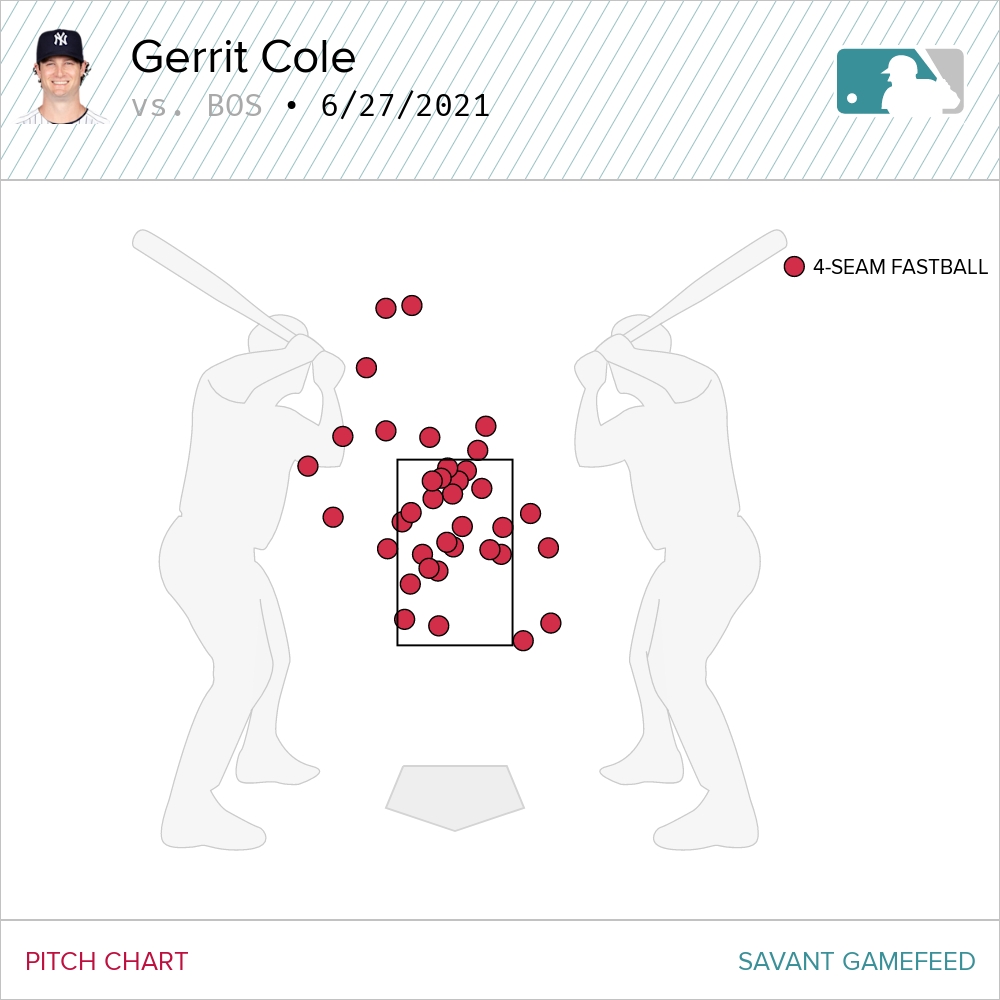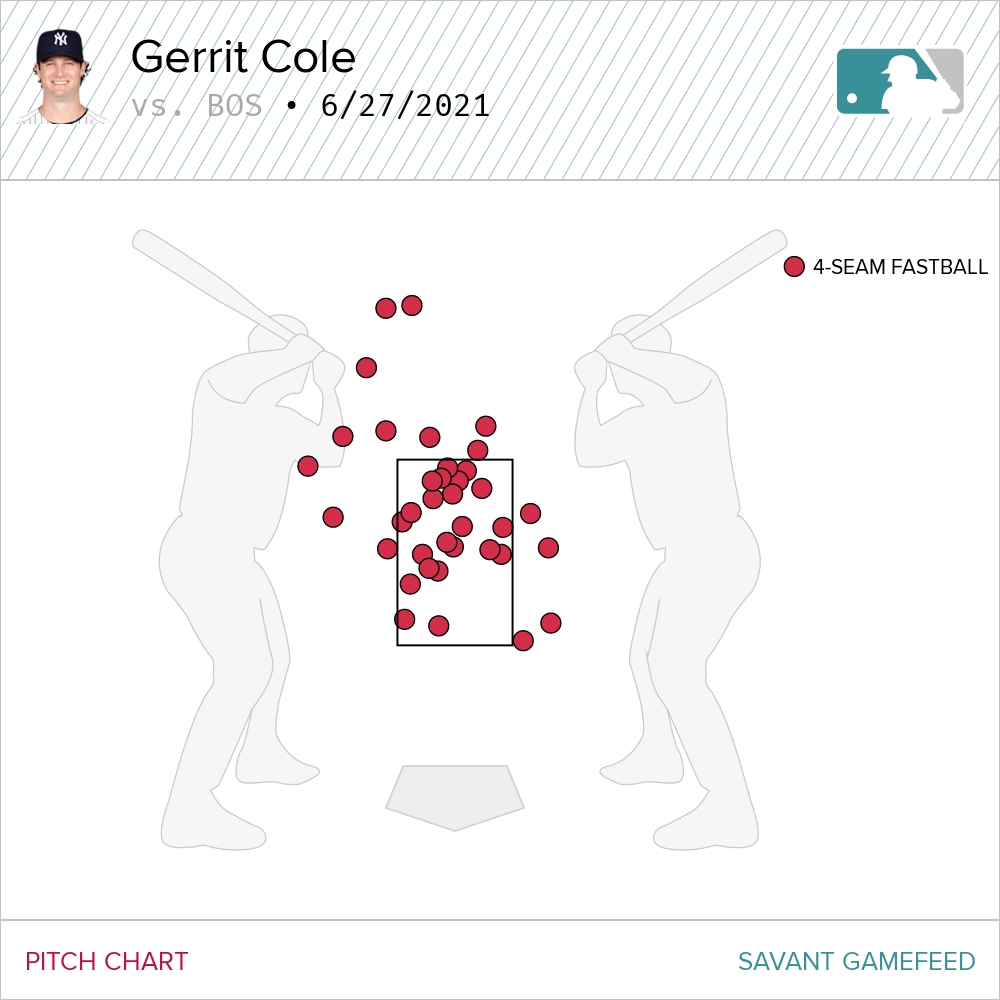While the foreign substance issue in baseball has lost its time in the limelight, Gerrit Cole was front and center in those conversations about the impact it had on pitchers. Following the implementation of the rule, Cole struggled mightily for several starts culminating in a start against the Mets on July 4th. In a seven-inning doubleheader, Cole was given a big lead but was unable to keep it and left the game in the third inning with the shortest outing of his career since he left Pittsburgh. Things were beginning to look bad for Cole as the optics of the situation were not in his favor. Yet, as the saying goes, it’s always darkest just before the dawn, Gerrit Cole’s end was exaggerated.
The Fastball Rebound
Riding into Houston after a series win against the Mariners and an opening win against the Astros, Gerrit Cole went out to face his former team for the first time since he left Houston to join the Yankees. It was his first time pitching in Minute Maid Park since the World Series in 2019. There was a lot of weight on this game for Cole and the Yankees. For the Yankees, taking two series against above .500 teams on the road going into the All-Star break would be big for a very inconsistent team. For Cole, he needed to answer the questions surrounding him about the foreign substance issues. The Astros ranked in the top of the league in strikeout rate and whiff rate, it would be a challenge for Cole but the key was the use of his fastball.
Cole has been using fastball less this year and in his previous starts since the crackdown, Cole had little to no faith in the pitch. In his start against the Mets, he went to his fastball a lot and just got a little unlucky with it, but the game plan was there. In a start where the Yankees ace needed his best stuff, he delivered. He threw a 129 pitch shutout to preserve a 1-0 win against his former team. How’d he get it done? He dominated with the fastball. Hitters went 1-14 against the pitch in his start against Houston. While much has been made about Cole’s spin rates, a 2350 RPM fastball is still a top-tier spin rate for a fastball, and that’s where Cole sat in his start against Houston. Even more importantly, Cole’s command of the pitch was greatly improved. Here’s a look at his fastball chart in a start against the Mets and Red Sox.


A lot of fastballs in the middle of the strike zone in those starts, and he got crushed. He hadn’t been able to adjust to pitching with no substances and wasn’t able to command his fastball in the ways that he needed to get outs. He needed to adjust to where he was aiming with his fastball and possibly work more east and west with it as well. Here is a chart of his fastballs against Houston.

Still a lot of fastballs in the middle of the strike zone but you can see a clear focus to throw more fastballs out of the zone as well. He was working up and down as well as in and out with his primary pitch. That’s why, when he came into the strike zone, he could get it past hitters or avoid damage because he had been keeping them off balance with it all night. He also threw 51% of the time in the game, above his season average. When Cole needed it most, he relied on the pitch that has made him into one of the best starting pitchers in baseball. Yet, it was just one start, a historically great one at that, but just one game wasn’t going to be enough to prove to people that he was still the dominant force that he had built himself into.
That’s where this past Saturday comes in. Once again, the Yankees were needing a big start from their ace. Winless against the Red Sox all year, the team sent their All-Star out to the mound with a chance to try and break that streak and prove Cole was still an elite pitcher. In hazardous conditions at best, Cole dominated for 6 innings of one-run ball. He struck out 11 Red Sox hitters, recording 16 whiffs on 96 pitches and a 40% CSW. It was his highest SwStr% in a start since May. You can probably guess where I’m going to go with this. Here’s a chart of Cole’s fastballs from that start.

His fastball was in vintage Cole form. Darting it at the top of the zone consistently while being able to work both sides of the plate. He threw it about 50% of the time while generating eight swings and misses. One could argue, it was the best his stuff had looked in months. Cole delivered at just the right time for the Yankees. While his fastball will be his main weapon, it’s his full arsenal that will help lead him on his quest for his first career CY Young award.
Cy Young Dreams
In the heat of the CY Young race, Gerrit Cole is competing with Carlos Rodon and Lance Lynn for the ultimate prize for a pitcher. Lynn and Rodon will have advantages for now as they haven’t gone through major struggles following the substance crackdown. Yet, Cole still offers the highest ceiling of the three of them because of his arsenal that includes four elite pitches.
Starting with his slider, Cole has seen a bit of a change in the shape of the pitch recently. In his last two starts, Cole has added some more vertical movement. It went up by 2 inches over his average in Houston and then 3 inches over his average against Boston. Since he can’t spin the ball like he uses to consistently, he’s probably trying to let the force of gravity take over more and bring the ball sharper down and away to righties. Here’s a slider he threw in his past start.
https://gfycat.com/hairydetailedbeaver
It can be a little difficult to tell but here is a slider from earlier in the year against the Blue Jays.
https://gfycat.com/unnaturaldishonestbrownbutterfly
You can see a little bit more downward tilt on the ball, not much but it’s there. This is an adjustment to try and give hitters a different look ever so slightly while also taking into account the lack of substance to help with his spin. It’s a smart adjustment that can go unnoticed but one of a veteran pitcher who is vying for changes to try and get himself back in a groove.
In his last two starts, Cole has become more reliant on his curveball as well. Cole’s curveball always graded out as an above-average pitch and yet he hasn’t thrown it more than 19% of the time in a single season in his career. His last two starts though he’s thrown it 20% of the time. Cole’s curveball has a 7:15 spin direction, meaning the pitch has more topspin than side spin and that’s why his curveball gets well above average vertical movement to it. Cole has likely become more reliant on it for the same reason he’s trying to have his slider move downwards more, without a great grip of the ball, it could be difficult for him to create a lot of sidespin. If he can instead get hitters to chase below the zone in the middle, it could help set up his off-speed down and away to right-handed hitters. Over his last two starts, Cole has thrown 39 curveballs, 16 of them have come on the first pitch. He’s trying to give hitters a different look early to help his fastball stay up on hitters. It’s a strategy that is proving to be effective.
Lastly, Cole’s changeup has seen some inconsistency. It’s his 4th best pitch so it’s not always needed for him to get by in a start. However, Cole has the highest groundball rate since 2017, his final year in Pittsburgh, and his changeup has played a big part in that. Yet, as mentioned, Cole could be having trouble generating a side spin on the ball, and his changeup is generating a lot of side spin when he throws it at a 2:00 spin direction. While he’s had no change on his movement measurements in his last two starts and he threw the changeup frequently against the Astros for a lot of success, it is something to pay attention to as he works deeper into the season. It’s a good pitch and the Yankees have tried to throw more changeups all year as a team. I don’t think Cole should get away from it.
The strategy for the Yankees ace is still the same as it always, get hitters out with fastballs up and off-speed down. Now, he’s using a different path to set up those finishing pitches. Willing to work the fastball more towards the sides of the plate and the curveball was a setup pitch to keep hitters off the fastball. With Cole’s ability to tunnel his slider and curveball, it will also make hitters more vulnerable to his slider, thinking it’ll break one way but then it breaks another. All of that leads to the ultimate point that Gerrit Cole should be viewed as the favorite to win the CY Young when it comes time for the award to be announced in November. While Lynn and Rodon are certainly outpitching him right now, Cole has several more innings than both of them and Rodon has never gone through this type of stretch before. It would not surprise me if either one of them both are having fantastic years but Cole could pitch 200+ innings this year and that’s a mark that neither Lynn nor Rodon will hit most likely. If Cole can continue to his newfound attack plan, he will likely be viewed as the favorite and continue to uphold his title as the second-best pitcher in baseball.
Photos by Mark LoMoglio/Icon Sportswire | Adapted by Aaron Polcare (@graphical_ark on Twitter)
